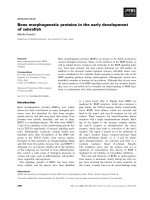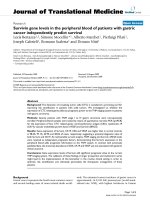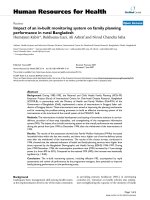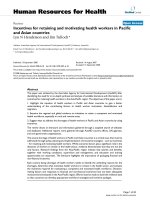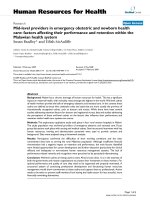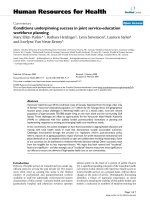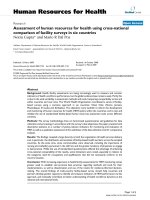báo cáo sinh học:" Where do students in the health professions want to work?" pptx
Bạn đang xem bản rút gọn của tài liệu. Xem và tải ngay bản đầy đủ của tài liệu tại đây (450.23 KB, 8 trang )
BioMed Central
Page 1 of 8
(page number not for citation purposes)
Human Resources for Health
Open Access
Research
Where do students in the health professions want to work?
Deborah Schofield*, Susan Fletcher, Jeffery Fuller, Hudson Birden and
Sue Page
Address: Northern Rivers University Department of Rural Health, School of Public Health, Faculty of Medicine, University of Sydney, Lismore,
Australia
Email: Deborah Schofield* - ; Susan Fletcher - ;
Jeffery Fuller - ; Hudson Birden - ;
Sue Page -
* Corresponding author
Abstract
Background: Rural and remote areas of Australia are facing serious health workforce shortages.
While a number of schemes have been developed to improve recruitment to and retention of the
rural health workforce, they will be effective only if appropriately targeted. This study examines the
factors that most encourage students attending rural clinical placements to work in rural Australia,
and the regions they prefer.
Methods: The Careers in Rural Health Tracking Survey was used to examine the factors that most
influence medical, nursing and allied health students' preference for practice locations and the
locations preferred.
Results: Students showed a preference for working in large urban centres within one year, but
would consider moving to a more rural location later in life. Only 10% of students surveyed said
they would never work in a rural community with a population of less than 10 000. Almost half the
sample (45%) reported wanting to work overseas within five years. The type of work available in
rural areas was found to be the factor most likely to encourage students to practice rurally,
followed by career opportunities and challenge
Conclusion: The decision to practise rurally is the result of a complex interaction between a
number of factors including ethnicity, discipline, age and sex, among others. Incentives that aim to
entice all students to rural practice while considering only one of these variables are likely to be
inadequate.
Background
Australia is a large country with a dispersed population of
about 21 million persons. Limited access to health serv-
ices remains a significant problem for people living in
rural and remote areas of Australia [1-4], due to difficul-
ties in attracting and retaining health professionals to
rural practice [5-9]. Various schemes have been devised by
the Australian government to improve the recruitment
and retention of the rural health workforce, such as the
introduction of scholarships, increasing the number of
students with rural background, and financial incentives
[1-3,5,10-14]. However, to be most successful they need
to target students most likely to work in such areas [3].
Published: 18 August 2009
Human Resources for Health 2009, 7:74 doi:10.1186/1478-4491-7-74
Received: 14 January 2009
Accepted: 18 August 2009
This article is available from: />© 2009 Schofield et al; licensee BioMed Central Ltd.
This is an Open Access article distributed under the terms of the Creative Commons Attribution License ( />),
which permits unrestricted use, distribution, and reproduction in any medium, provided the original work is properly cited.
Human Resources for Health 2009, 7:74 />Page 2 of 8
(page number not for citation purposes)
The current literature has identified a number of factors
that can influence clinicians in making location decisions.
Students from a rural background are more likely to work
in rural areas than those from urban backgrounds [1,3-
6,15-21], with the likelihood increasing if the practi-
tioner's spouse is also from a rural background [1,17,19].
Males are reportedly more likely than females to work in
rural and remote regions [1,5,22]. Students with under-
graduate or postgraduate training in rural areas are more
likely to return to rural practice than those without [1,3-
5,15,17,20,23,24]. Studies in a number of Australian
states have also demonstrated that undertaking rural
placements during the course of their study increases the
probability of subsequent rural practice and that longer
placements may increase rural practice outcomes [25-27].
There have been more studies on practice location prefer-
ence for doctors than for other health professionals. These
studies concluded that doctors typically choose to work in
rural areas for lifestyle reasons [3,19]. Health science stu-
dents reported that they are influenced to choose rural
practice by a combination of factors, including personal
and professional needs and social context [11], with these
factors also noted for a focus group of nutrition and die-
tetic students and recent graduates [16].
The current study aims to add substantially to previous
research by answering the questions "What factors most
influence medical, nursing and allied health students'
preference for practice location?" and "What are their
locations of preference?" This study is unique in that it
includes all health disciplines and takes account of family
factors that affect employment preferences. In addition, it
is specific about practice location and asks about the time
frame for preferred practice locations.
Methods
The Careers in Rural Health Tracking Survey (CIRHTS)
was designed to examine employment preferences and
decision criteria that medical, nursing and allied health
students use in determining whether to practise in a rural,
remote or urban setting.
The survey questions students in detail on many aspects of
their lives, and because the decision to move to a rural
area may also involve a partner or spouse, most items
have space for both student and spouse responses. The
five components of the survey are:
1. personal characteristics and family relationships (nine
items)
2. education and employment (six items)
3. location preferences (five items)
4. rural background (four items)
5. influencing factors (one item covering 18 factors).
Ethics approval was received from the University of Syd-
ney Human Research Ethics Committee in 2006. Further
details on the survey have been published in a previous
paper [28]. Data analysis was undertaken using SAS 9.1
(SAS Institute, Cary, North Carolina, United States of
America).
Results and Discussion
In the first year of CIRHTS, 243 students were invited to
complete the survey while on rural placement in northern
New South Wales (NSW). These students came from 11
different universities predominantly from the east coast of
Australia. The duration of the placements varied in length
from several weeks to several months. Students varied
from first to final year of their undergraduate clinical stud-
ies, with the exception of some medical students, some of
whose courses are by graduate entry.
Of the 243 students, 121 agreed to participate: a 50%
response rate. The study included 43 medical students
(36%), 46 nursing students (38%) and 32 allied health
students (26%). Allied health disciplines included phar-
macy, occupational therapy, physiotherapy, dietetics,
speech therapy, social work and podiatry. The ages of the
students ranged from 20 to 33 years for medical students,
19 to 47 years for allied health students and 18 to 56 years
for nursing students. Foreign ancestry (students identify-
ing themselves as being of any ancestry other than Austral-
ian/New Zealand) was more common among medical
students than among allied health or nursing students.
The nursing cohort, being older, was more likely to be
married or in a de facto relationship. A summary of stu-
dent demographics is provided in Table 1.
Rural background
Forty-eight students (40%) reported coming from a capi-
tal city or major urban centre (population > 100 000);
20% came from a regional city or large town (25 000 –
100 000). Fewer students (17%) came from a small town
(10 000 – 25 000), while 23% came from a small rural
community (< 10 000). There was a relatively larger pro-
portion of students from regional or rural backgrounds
than might be expected based on the distribution of the
Australian population, partly due to rural students' self-
selecting rural placements and some rural students having
enrolment or scholarship obligations to undertake train-
ing in a rural area.
Allied health and medical students were more likely than
nurses to have a capital city or major urban centre back-
ground (Fig. 1).
Human Resources for Health 2009, 7:74 />Page 3 of 8
(page number not for citation purposes)
Some 89% of the sample attended high school in Aus-
tralia, with 60% of them spending at least one year in a
school outside a capital city or major urban centre.
Location preferences
Figure 2 indicates that 40% of students want to work in
larger centres within one year, while small rural commu-
nities appear to be more attractive than cities in the longer
term (17% compared to 13% for capital cities, in 5+
years). Few students indicated that they would never want
to work in a rural area (10%). A large number of students
were unsure about working rurally (23% in a small town
and 28% in a rural community). Nearly half the students
(45%) were looking to work overseas within the next five
years. (It should be noted that students could select each
period more than once, e.g. happy to work in a capital
city, major urban centre or overseas in the next year.
Therefore, percentages within each category along the x-
axis do not add to 100. Percentages within each location
do, however.)
Students aged 30 or over were more likely to never want
to work in a capital city (p < 0.05). No students aged less
than 21 would never want to work in a small town or rural
community within Australia. Participants in their twenties
preferred to work in larger centres (>25 000) within a year,
but were open to work in more rural locations later in life.
Background appeared to play a major role in location
decisions, with students showing a preference for working
in a town size they were familiar with. One quarter of
those from a rural background never wanted to work in a
capital city, while another 38% were unsure about doing
so. On the other hand, the majority (57%) of students
with a capital city background wanted to work in a city
within one year, and around one third were unsure about
working outside an urban area.
Reflecting the background differences between disci-
plines, nursing students were most likely to never want to
work in a capital city, or were unsure about doing so,
while 28% wanted to work in a rural community of fewer
than 10 000 people within one year. Medical students, on
the other hand, were unsure about working outside urban
centres. This is most likely a demographic effect rather
than a disciplinary effect, with about three quarters of the
medical cohort reporting being from a capital city and
about half reporting foreign ancestry (migrants tend to
gravitate to Australian cities). One third of allied health
students wanted to work overseas within a year, with
another 46% wanting to leave Australia within five years:
a total of 80% of young allied health professionals.
Students of Asian descent were more likely to never want
to work in a town of fewer than 10,000 people than those
of either Australian or European ethnicity. Over half of the
European and Asian students in the sample wanted to
work in a capital city within one year, compared to 38%
of Australians. However, Europeans were also more likely
never to want a city-based job, with 24% saying they
would never work in a capital city, compared to 15% of
Australians and just 5% of Asian students. Ancestry
Table 1: Description of the student sample
Number Average age Female Married
(de facto relationship)
Have children Foreign ancestry Rural background*
Medicine 43 25.2 22 (51%) 6 (14%) 0 (0%) 22 (51%) 10 (23%)
Nursing 46 27.8 38 (83%) 13 (28%) 15 (33%) 8 (17%) 41 (89%)
Allied health 32 25.5 18 (56%) 3 (9%) 4 (13%) 9 (28%) 20 (63%)
*Rural background was defined as town of population less than 100 000.
Student background by disciplineFigure 1
Student background by discipline.
90
80
70
60
medicine
nursing
allied health
50
40
30
20
10
0
Capital
city
city wn
Small
to
Regional Rural
community
Human Resources for Health 2009, 7:74 />Page 4 of 8
(page number not for citation purposes)
reflects the background students most identify with and
may not necessarily reflect where the student was born.
The cities of Brisbane and Melbourne were the most
attractive to students, with 62% and 58% of respondents
saying they would be happy to work in each city, respec-
tively. Perth also fared well, with 49% of students pre-
pared to work in the western capital. Around a third of the
students were happy to work in the other capital cities of
Adelaide, Hobart, Darwin and Canberra. Few students
indicated they would like to work in rural regions of states
other than New South Wales (Fig. 3). Worst-off was the
northern region of South Australia, an area composed
mostly of desert, where only 2% of students would be
happy to work. Other desert areas fared better: 17% of stu-
dents said they would work in the Northern Territory or
the Kimberly region of Western Australia (WA). On the
other hand, just 4% of students were willing to work in
the south-eastern corner of WA.
Within NSW, the north coast area was the most popular,
with fewer students wanting to work inland (Fig. 4).
Despite this finding, only 38% of students said living
close to the coast was somewhat or very important to
them.
Preferences for future practice location were influenced by
the desire to undertake postgraduate studies for just over
half (56%) of the sample.
Influencing factors
The type of work available was the factor most likely to
influence the location preferences of students, with 51%
of the sample saying this would strongly encourage them
to work rurally and a further 23% reporting that it would
slightly encourage them to do so. Only two students indi-
cated that work type would discourage them from work-
ing in a rural area. Career opportunities and challenges
were also found to be strong encouragers of rural practice
(Table 2).
While their rural placement was not generally noted as the
most important reason influencing where they would pre-
fer to work, 65% of students reported their NRUDRH
Student location preferencesFigure 2
Student location preferences.
0%
5%
10%
15%
20%
25%
30%
35%
40%
45%
50%
Never Within 1
year
Within 5
years
After 5
years
Unsure
Capital city
Major urban centre
(>100,000)
Regional city (25,000-
100,000)
Small town (10,000-
24,999)
Small rural community
(<10,000)
Overseas
Average proportion of students wanting to work in rural Australia, by stateFigure 3
Average proportion of students wanting to work in
rural Australia, by state.
17%
17%
9%
7%
29%
8%
9%
Human Resources for Health 2009, 7:74 />Page 5 of 8
(page number not for citation purposes)
placement as a factor that would encourage them to work
in a rural area, with 50% of students also reporting a pre-
vious rural placement as being a positive factor. Only one
student reported the NRUDRH placement and only two
students another rural placement as a negative factor.
A number of students provided other reasons for wanting
to work in a rural area, including professional support,
coastal location, happiness, owning a farm, loving the
bush and wanting to live there, financial incentives and
work flexibility.
Factors that were less likely to encourage students to work
rurally were typically those that applied to only a minority
of students, and so were most often given a neutral rating,
including access to children (custodial arrangements) and
bonding or other contracting work requirements. Apart
from these factors, students were most discouraged from
rural practice by a lack of public transport. Students of
European ancestry appeared to be discouraged by the life-
style and culture of rural areas.
Conclusion
CIRHTS indicates that the decision of health professionals
to work in a rural location is not determined simply by
background (although consistent with other studies, rural
background was important [1,3-6,15-21]), but varies
between individuals and indeed locations as a result of
the complex interaction of many factors.
The choice is not simply between "rural" and "urban"
locations. Under the umbrella of the term "rural" there are
many different areas, each of which is attractive (or not)
to different people for different reasons. Studies that dis-
tinguish only between rural and urban, or between rural,
remote and urban, are likely to under- or overestimate the
likely shortages in certain areas.
The results of this study support those of numerous previ-
ous researchers who report a positive relationship
between rural placements and later rural practice [1,3-
5,15,17,20,23-27]. Of the students surveyed, only one
reported that the NRUDRH placement would discourage
him or her from working rurally in the future. With stu-
dents almost unanimously finding their rural placement
to encourage rural practice, further Government invest-
ment in rural placement initiatives would appear to be
worthwhile. Adams et al. noted four factors positively
associated with rural employment perceptions after a
rural placement: (1) friendliness and support in rural
areas; (2) isolation and socialization problems associated
with living and working in rural areas; (3) enjoyable
aspects of living in a rural area; and (4) opportunities that
working in a rural area provides, such as work autonomy
and the variety of skills used [11]. Shoo et al. noted that
students with a city background chose rural practice for
the beauty of the outdoors, to be close to the coast or to
be close to family, while those who stayed in the city cited
lack of rural exposure, graduate programme opportunities
and being close to home [25].
Proportion of students wanting to work in each region of New South WalesFigure 4
Proportion of students wanting to work in each region of New South Wales.
Murra
y
9%
Far
West
11%
North
Western
15%
Northern
45%
Ri
c
h
mon
d
-Tweed
58%
Mid-North
Coast 60%
Hunter
36%
S
y
dne
y
42%
Illawarra
30%
Murrumbid
g
ee
11%
South Eastern
26%
Central
West 19%
Human Resources for Health 2009, 7:74 />Page 6 of 8
(page number not for citation purposes)
This study demonstrated that student intentions about
practice location over the life course and in the short term
may differ from their longer-term plans. For older
respondents and those with children, a good environment
for raising children was an important factor encouraging
rural practice. Students may seek specific professional
and/or life experiences before settling into a practice loca-
tion. An unexpected and somewhat alarming finding of
the current study was the high proportion of medical,
nursing and particularly allied health students looking to
work overseas in the next five years. However, it may be
possible to design incentives that capitalize on this desire
for travel. Programmes whereby employees can work for
four years at reduced pay and take their fifth year as paid
leave are becoming more common in sectors such as
finance and education, and the introduction of similar
programmes for health professionals should be consid-
ered, particularly in rural areas.
Factors within two categories were consistently nomi-
nated as those most likely to influence student location
decisions: "career factors" (e.g. type of work, career oppor-
tunities and challenges) and "financial factors" (e.g. cost
of accommodation and cost of living). As these two cate-
gories appear to be the most important to students when
deciding where to work, emphasizing them when design-
Table 2: Factors most likely to encourage students to work rurally
Top influencing factor % saying "encourage" % saying "strongly encourage"
Age <21 Career opportunities 33% 33%
21–24 Type of work 18% 53%
25–29 Cost of accommodation
Type of work
21%
21%
65%
65%
30+ Environment for raising children 0% 60%
Sex Males Cost of living 38% 48%
Females Type of work 28% 41%
Children Yes Environment for raising children 0% 83%
No Type of work 25% 48%
Discipline Medicine Cost of accommodation
Challenge
28%
39%
44%
39%
Nursing Type of work 6% 56%
Allied health Career opportunities 56% 38%
Regional background Population
>100 000
Type of work
Cost of accommodation
Cost of living
33%
19%
29%
43%
48%
43%
25 000–100 000 Challenge 42% 42%
10 000–24 999 Type of work 0% 83%
<10 000 Rural lifestyle/culture 30% 40%
Ethnicity Australian/NZ Type of work 15% 57%
Asian Challenge 33% 50%
European Cost of accommodation 0% 75%
Human Resources for Health 2009, 7:74 />Page 7 of 8
(page number not for citation purposes)
ing initiatives to encourage rural practice should result in
greater effectiveness. The variety of work that rural doctors
undertake and the skill development that results is likely
to interest females, allied health students and those from
a city background, for example, as career factors are highly
important to these students. A focus on the cost of living,
on the other hand, may be especially useful in attracting
males, medical students, Europeans and students in their
late 20 s.
Given the large proportion of students who are unsure
about working rurally, appropriately targeted incentives
have the potential to significantly improve rural health
workforce numbers by persuading these students to give
rural practice a try. The Australian Government has
recently released a report summarizing the existing incen-
tives; most of these are for medical practitioners, a small
number for nurses and none for allied health, with the
exception of one mental health programme and the Uni-
versity Departments of Rural Health. There is a clear need
for further incentives for allied health professionals to
work in rural areas [29].
Competing interests
The authors declare that they have no competing interests.
Authors' contributions
DS led the study; DS and SP conceived the original study;
all authors were members of the project team and worked
on survey design; SF was the project officer who imple-
mented the survey and undertook the analysis. All authors
read and approved the final manuscript.
Acknowledgements
The authors wish to acknowledge Rupendra Shrestha for statistical advice
and analysis and the clinical seniors from the North Coast Area Health
Service, K. Kostal, S. Wagner and L Schultz, who were advisors on the sur-
vey. The University of Sydney is also acknowledged for providing a grant
that partially funded the survey.
References
1. Laven G, Beilby J, Wilkinson D, McElroy H: Factors associated
with rural practice among Australian-trained general practi-
tioners. Medical Journal of Australia 2003, 179:75-79.
2. Humphreys J, Jones J, Jones M, Hugo G, Bamford E, Taylor D: A crit-
ical review of rural medical workforce retention in Australia.
Australian Health Review 2001, 24(4):91-102.
3. Rolfe IE, Person SA, O'Connell DL, Dickinson JA: Finding solutions
to the rural doctor shortage: the roles of selection versus
undergraduate medical education at Newcastle. Australian and
New Zealand Journal of Medicine 1995, 25(5):512-517.
4. Hays RB, Nichols A, Wise A, Adkins P, Craig M, Mahoney M: Choos-
ing a career in rural practice in Queensland. Australian Journal
of Rural Health 1995, 3(4):171-174.
5. Wilkinson D, Laven G, Pratt N, Beilby J: Impact of undergraduate
and postgraduate rural training, and medical school entry
criteria on rural practice among Australian general practi-
tioners: national study of 2414 doctors. Medical Education 2003,
37(9):809-814.
6. Schoo AM, Stagnitti KE, Mercer C, Dunbar J: A conceptual model
for recruitment and retention: allied health workforce
enhancement in Western Victoria, Australia. Rural and Remote
Health 2005, 5(4):477.
7. Richards HM, Farmer J, Selvaraj S: Sustaining the rural primary
healthcare workforce: survey of healthcare professionals in
the Scottish Highlands. Rural and Remote Health 2005, 5(1):365.
8. Reamy J: Physician recruitment in rural Canada: programs in
New Brunswick, Newfoundland, and Nova Scotia. Journal of
Rural Health 1994, 10(2):131-136.
9. Bushy A, Leipert B: Factors that influence students in choosing
rural nursing practice: a pilot study. Rural and Remote Health
2005, 5(2):387.
10. Humphreys J, Hegney D, Lipscombe J, Gregory G, Chater B:
Whither rural health? Reviewing a decade of progress in
rural health. Australian Journal of Rural Health 2002, 10(1):2-14.
11. Adams M, Dollard J, Hollins J, Petkov J: Development of a ques-
tionnaire measuring student attitudes to working and living
in rural areas. Rural and Remote Health 2005, 5(1):327.
12. Jones JA, Humphreys JS, Adena MA: Rural GPs' ratings of initia-
tives designed to improve rural medical workforce recruit-
ment and retention. Rural and Remote Health 2004, 4(3):314.
13. Butler C, Sheppard L: The impact of undergraduate rural edu-
cation on recently graduated physiotherapists. Australian Jour-
nal of Physiotherapy 1999, 45(1):23-30.
14. Hegney D, McCarthy A, Rogers-Clark C, Gorman D: Why nurses
are attracted to rural and remote practice. Australian Journal of
Rural Health 2002, 10(3):178-186.
15. Eley D, Young L, Shrapnel M, Wilkinson D, Baker P, Hegney D: Med-
ical students and rural general practitioners: congruent
views on the reality of recruitment into rural medicine. Aus-
tralian Journal of Rural Health 2007, 15(1):12-20.
16. Heaney S, Tolhurst H, Baines S: Choosing to practice in rural die-
tetics. What factors influence that decision? Australian Journal
of Rural Health 2004, 12:192-196.
17. Tolhurst H, Adams J, Steward SM: An exploration of when urban
background medical students become interested in rural
practice. Rural and Remote Health 2006, 6(1):452.
18. Ward AM, Kamien M, Lopes DG: Medical career choice and
practice location: early factors predicting course comple-
tion, career choice and practice location. Medical Education
2004, 38(3):239-248.
19. Rabinowitz HK, Diamond JJ, Hojat M, Hazelwood CE: Demo-
graphic, educational and economic factors related to
recruitment and retention of physicians in rural Pennsylva-
nia. Journal of Rural Health 1999, 15(2):212-218.
20. Woloschuk W, Tarrant M: Does rural education experience
influence students' likelihood of rural practice? Impact of
student background and gender. Journal of Rural Health 2002,
18(4):492-493.
21. Woloschuk W, Tarrant M: Do students from rural backgrounds
engage in rural family practice more than their urban-raised
peers? Medical Education 2004, 38(3):259-261.
22. Scammon DL, Williams SD, Li LB: Understanding physicians'
decisions to practice in rural areas as a basis for developing
recruitment and retention strategies. Journal of Ambulatory Care
Marketing 1994, 5(2):85-100.
23. Brooks RG, Walsh M, Mardon RE, Lewis M, Clawson A: The roles
of nature and nurture in the recruitment and retention of
primary care physicians in rural areas: a review of the litera-
ture. Academic Medicine 2002, 77(8):790-798.
24. Eley D, Baker P: Does recruitment lead to retention? Rural
Clinical School training experiences and subsequent intern
choices. Rural and Remote Health 2006, 6(1):511.
25. Schoo A, McNamara K, Stagnitti K: Clinical placement and rural-
ity of career commencement: a pilot study. Rural and Remote
Health 2008, 8(3):964.
26. Larson A, Playford D, Wheatland B: Whither Rural Health Students? Pre-
liminary analysis of the student tracking project, Western Australia Gerald-
ton: Combined Universities Centre for Rural Health; 2004.
27. Dalton L, Routley G, Peek K: Rural placements in Tasmania: do
experiential placements and background influence under-
graduate health science student's attitudes toward rural
practice? Rural and Remote Health 2008, 8(3):962.
28. Schofield D, Fuller J, Fletcher S, Birden H, Page S, Kostal K, Wagner
S, Schultz L: Decision criteria in health professionals choosing
a rural practice setting: development of the Careers in Rural
Publish with Bio Med Central and every
scientist can read your work free of charge
"BioMed Central will be the most significant development for
disseminating the results of biomedical research in our lifetime."
Sir Paul Nurse, Cancer Research UK
Your research papers will be:
available free of charge to the entire biomedical community
peer reviewed and published immediately upon acceptance
cited in PubMed and archived on PubMed Central
yours — you keep the copyright
Submit your manuscript here:
/>BioMedcentral
Human Resources for Health 2009, 7:74 />Page 8 of 8
(page number not for citation purposes)
Health Tracking Survey (CIRHTS). Rural and Remote Health
(online) 2007, 7(3):666.
29. The Auditor General: Rural and Remote Health Workforce Capacity –
the contribution made by programs administered by the Department of
Health and Ageing Canberra: Australian National Audit Office; 2009.
